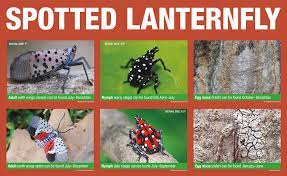
SACRAMENTO, July 16, 2021 – A state exterior quarantine has been declared to prohibit the introduction of the spotted lanternfly (SLF), Lycorma delicatula, into California. Spotted lanternfly was first detected in North American in 2014 in Pennsylvania and has now spread to nine states.
The quarantine prohibits the entry into California of SLF, its host plants, and a variety of articles, including conveyances, originating from any area where an SLF infestation exists. Specifically, articles and commodities covered by the quarantine include the following:
• Spotted lanternfly, a harmful invasive species that threatens California’s agriculture and natural resources,
• All plants and plant parts including firewood, if exposed to the environment,
• Outdoor industrial and construction materials, equipment, and waste,
• Shipping and storage containers including personal moving containers,
• Outdoor household articles,
• Conveyances of any type including but not limited to, cars, trucks, recreational vehicles, boats, and trailers,
• Agricultural equipment including but not limited to, tractors, harvesting equipment, and rigid containers,
• Any other article, object, materials, or means of conveyance when it is determined by a California State Plant Quarantine Officer to present a risk of carrying or spreading any life stage of SLF.
All the articles and commodities covered above are prohibited entry into California from areas under SLF quarantine with the following exceptions:
• Certificate of Treatment issued by an authorized state agricultural official,
• If originating outside of a SLF infested area and moving through a SLF infested area during March through December, the regulated article must be in an enclosed vehicle or conveyance or completely covered,
• Any articles transported by a conveyance that has a GPS data report indicating that it did not travel through a SLF-infested area,
• Indoor articles not exposed to the environment, including, but not limited to, household articles, house plants, and indoor furnishings,
• Articles and commodities covered above that are accompanied by the appropriate permit, phytosanitary certificate, Compliance Agreement, or checklist for individuals moving from a SLF infested area into California.
The spotted lanternfly feeds on at least 103 species of plants (mostly trees) in 33 families. The immature stage (nymphs) is much more polyphagous than the adults, which strongly prefer tree of heaven (Ailanthus altissima) and grapes (Vitis species). Other hosts include maples, birches, hickory, beech, ash, apple, stone fruit, oaks, and willows. Their feeding produces large quantities of fluid, referred to as honeydew, that covers stems and leaves and promotes the growth of sooty mold. The feeding weakens the plants, and the sooty mold that grows on the honeydew decreases photosynthesis, which may have a greater impact on the plant than the feeding itself. Infestations weaken the plants and can eventually kill them.
SLF can move between natural landscapes and agricultural production. SLF egg cases are deposited on trees (especially trees with smooth bark) as well as a wide variety of outdoor objects–natural and manmade–including vehicles, recreational vehicles, stone, outdoor furniture, and storage and moving containers. The most likely pathway for long-distance spread of this invasive species is the movement of SLF egg cases.
In addition to this quarantine, CDFA has taken the following proactive steps to protect California from SLF including, but not limited to, A-rating from the California Primary Entomologist, training for county regulatory staff through CDFA’s Pest Prevention University, advisories to state/county staff, Border Protection Station inspections, air cargo inspections, dog teams in parcel facilities looking for unmarked packages, CDFA participation in national SLF Summit and coordination meetings, yearly visual survey for SLF in California, creation of a Science Advisory Panel to inform development of an SLF action plan to be used if SLF is detected in California, training module for UC Master Gardeners, host specificity testing, risk based maps and models, research on suitability of specialty crops, and biological control research.
More information on the SLF can be found here – http://www.cdfa.ca.gov/plant/PDEP/target_pest_disease_profiles/spotted_lf_profile.html
More information on the SLF quarantine can be found here – https://www.cdfa.ca.gov/plant/Regulations.html
Checklist for individuals moving from a SLF infested area into California can be found here – https://www.cdfa.ca.gov/plant/pdep/docs/Spotted_LF/SLFChecklistCA.pdf
If you believe you have seen the spotted lanternfly, please contact our Invasive Species Hotline at 1-800-491-1899, via Report a Pest- https://www.cdfa.ca.gov/plant/reportapest, or by contacting your local County Agricultural Commissioner here – https://wwyw.cdfa.ca.gov/exec/county/countymap/
Contact:
Steve Lyle
Director of Public Affairs
California Department of Food and Agriculture
916-654-0462 [email protected]
